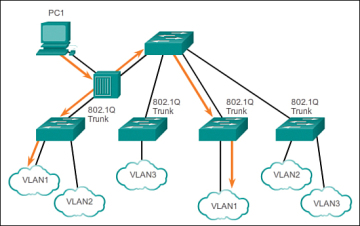Hello Mohammad.
Frames that are placed on a trunk include a VLAN tag. Switches know to which VLAN to forward a frame that is received on a trunk interface by this tag. If however for some reason, there is no tag on a frame that is received, the switch must know what to do with it. The Native VLAN configuration essentially tells the switch on which VLAN any UNtagged frames should be placed.
Now if you have connected two switches with a trunk, it is highly unlikely that any frame will arrive without a tag. (If it does, then there is a problem with some configuration). However, if you have a hub between two switches connected with a trunk and you have a PC connected to that hub, then you will definitely receive untagged frames on the trunk ports. Take a look at the following diagram:
Any frames sent by the PC will hit the trunk ports on the two switches untagged. The switches must know what to do with them. This is why the native VLAN must be configured, otherwise these frames will be dropped.
The truth is that such a topology is a very bad idea. You should never create such a network. The capability of switches to deal with untagged frames however must be applied and configured in order for trunks to function correctly from end to end.
I hope this has been helpful!
Laz
